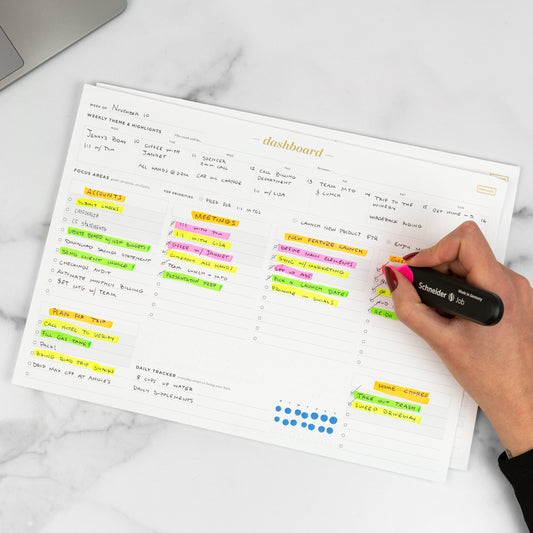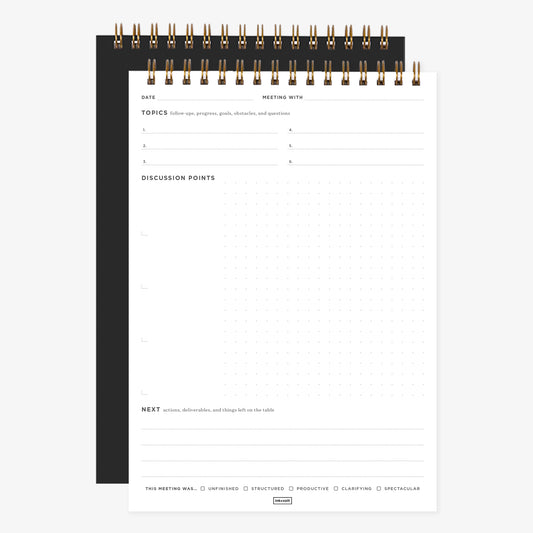How do you contribute to a meeting when you don’t feel like you have your footing yet or are the lowest rung on the ladder?
It’s not uncommon to feel like you don’t have much to contribute, especially when you’re early in your career or new to an organization. Staying quiet and deferring to more experienced colleagues is a normal reaction, but you don’t want to stay quiet too long, especially if you want to become a leader on the team and grow your impact.
So how can you look smarter in meetings if you feel like you’re not the smartest one in the room? In this post, we’ll share some of our best strategies for making an impact in the conference room and leveling up your meeting skills so that you can impress (even when you’re still figuring things out!).
Start by defining what success in a meeting looks like
Looking smart in a meeting isn’t just about talking the most. (In fact, the people who are talking the most are often contributing the least value.)
Instead, it is about moving the conversation forward in a productive way. What is the goal of this meeting? How can you contribute to that goal? It could be by delivering a really strong presentation, but it could also be as simple as asking a smart question that gives clarity to everyone in the room on something important.
One way to make a good impression and build your confidence is to take advantage of the nature and structure of meetings. Meetings typically give you the benefit of having advance notice of what will be discussed, which works in your favor. It’s a designated time to focus on one (or just a few) issues, and the people needed for the discussion are all in one place, so you can prepare fairly effectively with a little bit of effort.
So, in anticipation of the next meeting you’re attending, think of it as a three phased event because a meeting is more than just showing up:
- pre-meeting preparation
- attending and contributing to the meeting
- the post-meeting debrief with yourself
With these phases in mind, here are some recommendations for how you can look smarter in your next meeting and make a positive contribution.
Pre-meeting preparation: it’s worth the time!
Your contributions to a meeting are only as good as your preparation for it. The time you invest up front is key to your success. As with many things in life, and the more prepared you are, the more knowledgeable you’ll be and the smarter you’ll come across.
Soon after accepting a meeting invitation or being notified your attendance is required, try some of these steps to get yourself as prepared as possible:
Understand why you were invited
Were you invited to shadow another person, is this an all staff monthly meeting, or is it a team meeting with internal stakeholders and you’re representing your unit? This will give you a sense of what others are expecting of you and allow you to prepare accordingly.
Identify attendees
If you received the meeting invite electronically, see who else is attending. Using your email’s address book or company directory, look up each person, their title, and consider what their role is at the meeting, if unknown. Where do you fit into this group? Why have you been included? Make note of attendee information for later.
Review the topic(s) to be discussed
It may seem obvious, but if you’re new to a role and still learning the basics, set aside a few hours to study what the meeting will be about. If there’s an agenda (or you ask for one in advance if one isn’t provided), then you’ll have even more information to go off of to help you prepare effectively.
What is going to be discussed and how familiar are you with the subject matter, issues, problems, etc? Identify what you know and what you don’t know, whether it’s a process, a policy, a particular law, or the terminology. For those items that are a question mark, take the time to research the unknown in advance! This shows initiative and you’ll also become more knowledgeable, which is always a good thing.
Utilize manuals, policies, previously prepared documents, or past projects to guide you. Maybe look for examples of how similar situations were handled in the past to give you a feel for possible solutions, similarities, and/or differences.
Remember, even if the agenda or subject for the meeting says one thing, it could go a different direction once you’re in it; if possible, think of related issues that might be connected to the anticipated topic and, again, research those in advance too.
Brainstorm questions and/or ideas
Once you’ve done your research and are more familiar with the topic(s), prepare a draft of all your questions or ideas. You might not end up using all of them, but this will help you be prepared so you don’t have to try to think of everything on the fly.
Select your note-taking device of choice for the meeting
Will you be bringing a pad and pen to the meeting? Maybe you’ll type out your notes and questions and print the document in advance? Or, maybe it’s appropriate to utilize a tablet or laptop. Depending on your workplace’s culture and norms, make your selection based on what you’re most comfortable with, but also based on what your fellow coworkers use.
Simpler is probably better until you get a feel for what is acceptable. Whatever you choose, write or type out in advance of the meeting the following (doing it at the start of the meeting could look a little haphazard):
- Date
- Attendees and title/roles
- Topic(s) to be discussed
- Relevant notes you’ve taken in advance for reference
- Your questions and/or ideas
Now, you’ll be prepared to contribute to the meeting, and at a minimum be knowledgeable enough to follow along. Looking and feeling smarter already!
The day of the meeting
The day of the meeting, make sure you review your notes and questions so that they are fresh in your mind, and remember:
Leave yourself enough time before the meeting to do a quick touch up to ensure you look presentable and professional
Take care of any other personal items, like having a snack so your tummy’s not growling, or having your drink of choice ready. You do not want to keep people waiting, especially if you are still working to build credibility.
When you sit at the table, sit up straight and make eye contact with the other attendees. Listen actively and keep your face engaged. You can have tons of presence even without speaking by simply holding yourself in a posture that reflects confidence and poise.
Arrive early enough so you can get a seat that is appropriate for you, yet is well positioned
You’re also being respectful of the other participants’ time by being early. You’ll also show that you’re prepared, and you won’t be as flustered trying to grab a seat at the last minute while things are getting started.
Make sure you sit somewhere that you can see, and take a place at the table unless there is a specific reason why you should be sitting in the back (if it is a large all-hands meeting, for example). When you’re new or not confident, it can be tempting to want to hide in the back, but you should take yourself seriously and take a seat at the table where you belong.
During the meeting, take notes!
You never know who is watching or who may ask you about something that was said in the meeting, even if you’re not the designated note taker. Taking notes shows that you are paying careful attention, and it also gives you a record that you can refer back to anytime. This is especially helpful if you are new to a team, since you are likely taking in tons of new information, which can be hard to retain.
Ask your prepared questions or share your ideas when it’s appropriate
As the meeting progresses though, new questions may come to mind or your prepared questions may become obsolete or answered; ask questions that are relevant to the present discussion.
Also recognize that some questions may involve more detailed answers that can be discussed in more depth after the meeting. In that case, you can couch your question with “I have a question about [subject of question]. It may be better to talk about this in more depth after the meeting, but I’m curious if ___.”
If a question isn’t totally relevant, don’t ask it just for the sake of having something to say. Instead, email it to the appropriate person later.
If you don’t have something to contribute, look for other ways to add value
There are other ways to make a positive impact on a meeting besides just asking questions or talking. For example, if there are a lot of ideas being discussed at once, you can hop up and start recording things on the whiteboard or offer to collect all the ideas in your notes to mail out after the meeting.
This is a great way to show initiative and keep the meeting productive, even without adding other input if you don’t have any.
Post-meeting wrap up
The hard part is over! Hopefully the meeting went well, you learned something new, and your coworkers and manager recognized your effort and smarts. Before too much time passes by:
Type up your notes and be willing to share them
A great way to add value to your fellow meeting attendees is to share your notes with them. Really good followup notes won’t just be a transcript of what was said, though — nobody really needs that. Instead, go through your notes and highlight important things like next steps (what needs to be done, by whom, by what date, etc) and questions to be answered.
Even if you haven’t been asked specifically to do this, it can be very helpful. (Just make sure there isn’t someone already tasked with this job specifically — you don’t want to step on any toes.)
When you are compiling your notes for sharing, focus on making them skimmable and packed with value. Be ruthless about cutting information that doesn’t need to be there, and use things like bold text, underlines, etc to make important points stand out.
The best way to share your notes is to simply paste the final, edited version of them in the email to everyone. Asking people to open a separate document or link is creating more work for them that they may not be likely to do, and your goal here is to add refreshing, helpful value (not an extra job to do!).
Follow up with the meeting’s attendees in writing if necessary
A really good meeting is one that pushes progress forward. That means that at the end of the meeting, attendees will leave with a clear idea of what is supposed to happen next and what their role will be in that progress.
Make sure you connect with any people who will be a part of your next steps. Do this quickly after the meeting so that the information is still fresh in their mind and you won’t be held up.
If someone coordinated setting up the meeting, send a thank you their way for their efforts.
This is a good idea for a more formal meeting where more effort may have gone into the preparation. However, it is not necessarily needed for a more informal meeting or one with a small group.
How do you make an impact in meetings?
It is natural to feel a little overwhelmed in meetings where you’re not exactly sure where you stand. However, it is within your power to take control and make sure that you are doing the very best that you can.
After all, why spend time sitting in a meeting if you’re not making it count?
Share your favorite ways to be amazing in meetings with us on Facebook!









